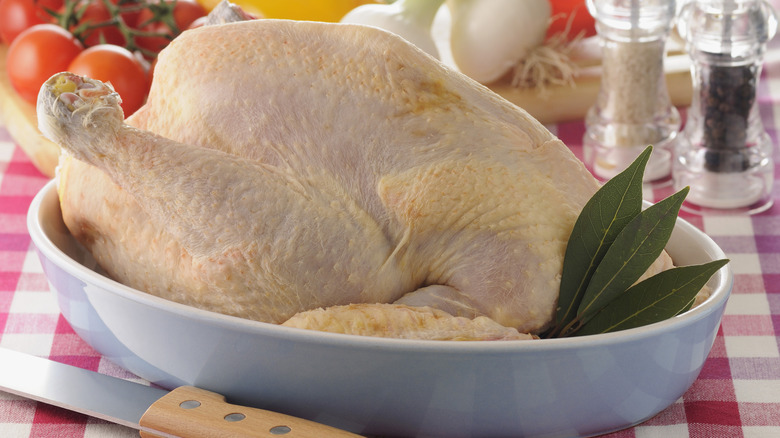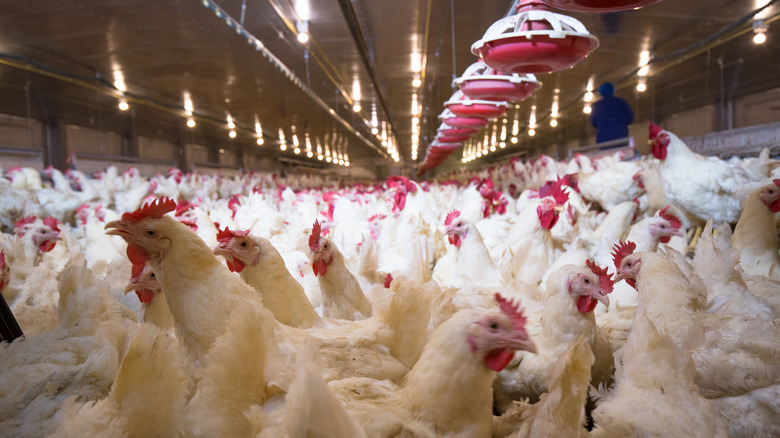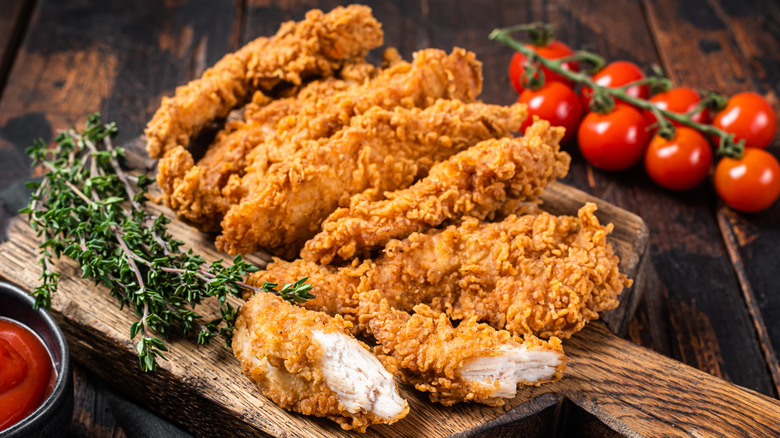Things You Might Want To Consider Before Eating Chicken
As we enter the new year, most of us are well and truly stuffed following our festive roasts. But when turkey isn't on the plate, it's chicken. Renowned for its chewy, soft texture, much of chicken's popularity lies in its versatility. Be it fried, grilled, or sautéed in a stir fry, chicken can be cooked in all sorts of ways and is a global favorite utilized in a plethora of national cuisines. But there is one nation that trumps all others in its penchant for poultry. As Vox highlights, during the 2021 Super Bowl, Americans consumed 1.4 billion chicken wings and drumsticks. Since 1970, the amount of chicken meat we consume has more than doubled, and it's showing no signs of slowing. But is chicken really all that it's clucked up to be?
Often perceived as the more innocuous alternative to red meat, chicken undergoes several processes from factory to plate. And as is often the case, what we see on grocery aisles doesn't quite reflect what actually goes on behind the scenes. In order to make chicken palatable for human consumption, for instance, factory-farmed birds are subject to quite a bit of medical intervention. Moreover, the consumption of chicken is associated with a wide variety of ailments, leading us to ponder whether it really is that good for us. From nasty surprises lurking inside your bird to the staggering effects of having too much of a good thing, let's explore why you should rethink eating chicken.
Chicken is a major source of food poisoning
Ever felt queasy after eating a chicken dinner? You're not alone. Chicken is one of the biggest sources of food poisoning. According to the Centers for Disease Control and Prevention, a whopping 1 million Americans suffer from poultry-related food poisoning each year. Bacteria associated with the condition include Salmonella, which can potentially cause serious illness, though many cases are mild, per U.S. News and World Report. In 2022, a study by Consumer Reports found that Salmonella was present in nearly one third of ground chicken sold at grocery stores. "The message: Salmonella in ground chicken is more common than it should be," warned food safety expert James E. Rogers. "This is not an isolated or contained problem."
In order to avoid food poisoning, be sure to cook chicken properly. As Insider highlights, many folks rely on the color and texture of chicken to ascertain whether it's properly cooked. However, lab tests showed that such methods don't necessarily guarantee that potentially harmful bacteria has been killed off. Your best bet for preventing food poisoning is to check that the color of your bird is uniform and thus cooked thoroughly. "Primarily, consumers should check that all surfaces of the meat are cooked, as most bacteria are present on the surface," explained Solveig Langsrud, a scientist at the Norwegian Institute of Food, Fisheries and Aquaculture Research. "Secondly, they should check the core. When the core meat is fibrous and not glossy, it has reached a safe temperature."
Factory farming has devastating effects on the environment
One of the biggest contributors to climate change is factory farming. In 2010 alone, animal agriculture was responsible for 75% of global emissions, and it's only getting worse (via the Food and Agriculture Organization). As Vox points out, while mass production of meats such as beef is the most destructive for the environment, there is a common misconception that the farming of chicken is more sustainable. However, this is not the case. For instance, a single serving of poultry requires the emission of 11 times more greenhouse gasses than a serving of beans, per Factory Farming Awareness Coalition.
In addition to its devastating impact on the environment, many argue that factory farming is a cruel practice. Of all the animals slaughtered in the U.S., chickens make up 90% of that figure, and they are also the most abused, facing death by boiling, suffocations, freezing, and drowning, per The Guardian. A study by Global Animal Partnership found that chickens experience immense pain and suffering when farmed. Being confined in cramped spaces leads to decreased mobility for the birds and thus painful injuries, including lesions and burns.
If you're wondering how you can still consume chicken sans the cruelty, Deseret News suggests ditching mass-produced poultry and instead seeking out local and family-owned farms. Additionally, price is usually an indicator of ethics: If that rotisserie chicken comes at an unbelievably low price, it's usually at a high cost for the bird itself.
Some chicken dishes carry heart disease risks
Although chicken is often touted as a healthier alternative to, say, beef or pork, there are nonetheless various risks associated with its consumption. A 2019 study by the American Journal of Clinical Nutrition found that consumption of white meat, such as chicken, increases cholesterol levels in a similar way to red meat. According to a study by Cornell and Northwestern universities, chicken was also found to increase the risk of heart disease, per The Sun. In fact, consuming chicken just twice a week may increase a person's risk of developing heart problems. The study initially looked at the consumption of meat in general, so the findings came as somewhat of a surprise since poultry is often viewed as a heart-healthy choice. "Modifying intake of these animal protein foods may be an important strategy to help reduce the risk of cardiovascular disease and premature death at a population level," said Cornell researcher Victor Zhong.
According to the British Heart Foundation, the increased risk may be due to the way in which the chicken is cooked. Fried or processed chicken, for instance, is more likely to cause heart disease than boiled chicken. Moreover, the culprit for unhealthy chicken dishes is often attributable to added salt and fat as opposed to the meat itself. Try some heart-healthy chicken recipes to avoid putting strain on your body.
Chicken may contain low levels of arsenic
In 2015, a study by the FDA concluded that almost 70% of U.S. chicken contains arsenic (via MSN). According to the study, arsenic, which is potentially poisonous, is added to chicken to give it a faux healthy appearance. The source of the arsenic is Roxarsone, a drug that is given to the birds to facilitate weight gain and thus a plump and appetizing veneer for consumers.
As Mother Jones points out, the use of arsenic-containing drugs in chicken farming dates back to the 1940s, when the industry sought to control outbreaks of coccidiosis, a parasite commonly found in the birds' intestinal tracts. That was all well and good in the '40s, when factory farming was at a relatively small scale, but with the boom in animal agriculture, and hence mass production of poultry, producers have found it more difficult to control in recent decades. Subsequently, Roxarsone additives were introduced to chicken feed. Although The Wall Street Journal notes that the level of arsenic is fairly low, it's nonetheless concerning that literal toxins could be in our chicken dinners. Moreover, chronic consumption of said toxics can lead to a variety of serious illnesses, including cancer.
According to the FDA, there are ways to avoid consuming dangerous amounts of arsenic in food, namely eating everything (including chicken) in moderation and including wide range of healthy foods in your diet.
The terrifying link between chicken and antibiotic resistance
As the World Health Organization highlights, antibiotic resistance is a huge threat to humanity. In the future, we may find that certain conditions, such as pneumonia, tuberculosis, STDs, and forms of food poisoning, have become resistant to antibiotic treatment. A major source of this resistance is chicken.
When farmed for food, chickens are pumped with antibiotics on a daily basis: That's equivalent to 63,151 tons of antibiotics a year, per The Guardian. The birds are fed these drugs to prevent disease, thereby making them safer when humans consume them. But it comes at a terrible cost. When folks eat those antibiotic-pumped chickens, they in turn consume the drugs themselves, potentially leading to antibiotic resistance. Subsequently, the prevalence of antibiotic resistance is growing exponentially; by 2050, it could cause as many as 10 million deaths a year.
Public health journalist Maryn McKenna tells NPR that even if chicken packages are labeled as "organic," it's still best to be wary. This is because organic regulation for chicken doesn't begin until chicks are a couple of days old, meaning that they could have been filled with antibiotics in their first day of life. McKenna advises looking for labels such as "raised without antibiotics" instead.
You may get some icky surprises
Does your chicken contain literal poop? Alas, it's highly likely. As CNN reports, an alarming number of store-bought chicken in the U.S. contains fecal matter. The worst part? Slightly poopy poultry is entirely legal. Although the U.S. Department of Agriculture has a zero-poop policy when it comes to chicken, this is only applicable to any visible feces, meaning that traces of fecal matter may very well be present in your next family bucket.
The Physicians Committee for Responsible Medicine told CNN that fecal matter was found in an eye-watering 48% of chicken products analyzed. An anonymous whistle-blower revealed to the committee that it's a common occurrence for birds that still have their intestines attached to be on production lines. "You're eating dung," Dr. Neal Barnard of the PCRM told the Huffington Post. "Chicken feces may also contain roundworms, hair worms, tapeworms, insect larvae, fecally-excreted drugs and other chemicals, as well as the more normal constituents of feces — bile, undigested food, etc."
In the U.K., one unlucky and unsuspecting consumer found fecal matter leaking out of the chicken she bought at the grocery store, per Metro. "I noticed a little mark like a bruise," the woman recalled. "I tried to just scratch it off and then the skin opened and out it poured. ... I was just disgusted, I felt sick." Big yikes. This one might make you think twice before tucking into a pile of chicken wings.
Too much of a good thing?
Not everyone who eats chicken in excess is addicted to it. Chicken is a versatile and readily available food staple, so it's pretty easy to end up consuming it on a frequent basis. But like most good things, chicken is best eaten in moderation.
According to DNA India, eating chicken too frequently can have some surprising side effects, such as a susceptibility to urinary tract infections (UTIs). This is largely the effect of eating low-quality and processed poultry, so opt for fresh chicken to avoid this rather unpleasant side effect. A study by the University of Minnesota elaborates on this claim; the source of this increased risk is due to the presence of a sub-variety of E. coli, which is common in chickens and therefore passed onto the humans who eat it, which causes UTIs.
As Men's Health notes, chicken is still a great dietary choice, but it's best consumed as part of a diet that is, above all else, rich in plants rather than meat. So, there's no need to ditch the chicken dinners entirely; simply enjoy it in moderation and experiment with protein alternatives on your paltry poultry days. Or, you can swap chicken entirely for plant-based alternatives, such as marinated tofu or battered cauliflower.
This is how chicken is best eaten
When eating chicken, it's important to consider the potentially harmful effects associated with it. The best way to do this is to change up the way you cook chicken. Although there's nothing wrong with enjoying fried chicken in moderation, there are lots of other, more hearty ways to enjoy it.
"The healthiest way to cook chicken is to poach it," registered dietitian Rebecca Lewis told Women's Health, "because you aren't introducing any other ingredient to the chicken other than the water it is boiled in." To avoid skimping on flavor with this method, Lewis recommends adding lots of herbs, spices, and vegetables to the pot. If poaching isn't particularly appetizing for you, try grilling instead. With this method, it's recommended that you coat the chicken with a moderate amount of olive oil, which contains fats that are actually beneficial for you. You can also try marinating the chicken before tossing it onto the grill, which will enhance its flavor.
Alternatively, you can bake your chicken, which is another healthy preparation method. Speaking to The Atlantic, food expert Marion Nestle recommends removing the skin of chicken before putting it in the oven. She also advises paying more for your meat to circumvent many of the ethical concerns surrounding cheap, readily available chicken. Pricier chicken is more likely to be free range, whereas the inexpensive stuff is usually bred under cruel circumstances, and pumped full of all the nasty surprises previously mentioned.








